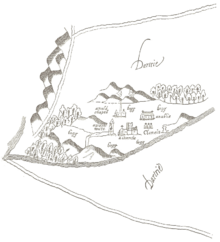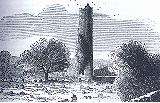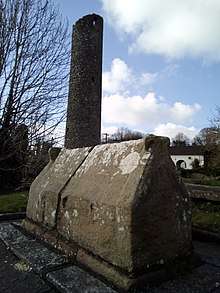Clones Abbey
Clones Abbey is a ruined monastery that later became an Augustinian abbey in the twelfth century, and its main sights are ecclesiastical. The Abbey was formerly known as St. Tighernach Abbey, and was referred to locally as the "wee abbey". Parochial and monastic settlements were separated, and it seems likely that the building became the Abbey of St. Peter and Paul.
| Clones Abbey | |
|---|---|
| Native name Mainistir Cluain Eois | |
 Location of Clones Abbey in Ireland | |
| Location | County Monaghan, Ireland |
| Coordinates | 54°10′59″N 7°14′01″W |
| Area | Clones |
| Built | 12th century |
National Monument of Ireland | |
| Official name: Clones Abbey, Clones Church, Clones Round Tower | |
| Reference no. | 111 & 112 |

History


The Town of Clones and the Abbey was founded by St. Tigernach (anglicised St. Tierney) in the 6th century. St. Tigernach or Tierney's abbey was dedicated to St. Peter and St. Paul. The abbey was destroyed by fire in 836, 1095, and in 1184. In 1207, Hugh de Lacy destroyed the abbey and town; but five years after they were rebuilt by the English, who also erected a castle here. The ruins of a 12th-century abbey can be found on Abbey Street, along with a sarcophagus with worn animal-head carvings reputed to have been built to house the remains of St. Tigernach, and a 9th-century truncated 22m-high round tower, which was originally about 75 ft high and had a conical cap;[2] and a well-preserved 10th-century high cross on the Diamond, decorated with drama-charged biblical stories such as Daniel in the lion's den, Abrahams sacrifice of Isaac, Adam and the tree and the serpent. On the reverse side, new testament scenes are illustrated. The multiplication of the loaves, the miracle at Cana, the baptism of Christ.
The Protestant reformation lead to the suppression of the monasteries by Henry VIII in the 16th century, and the monastic settlement in Clones was destroyed. By the 17th century the abbey was a ruin, but solitary monks continued to live in the locality up until the 18th century. An English garrison was later established within the ruins.[3][4][5]
Style
The church is Romanesque in style and is evidence of the Roman church in Clones. The round-headed window is interesting, the head of which was cut out of a single stone. On the northern wall there is a small Celtic cross sculptured in relief on a stone.[3][4]
See also
List of abbeys and priories in Ireland
Abbot of Clones
The Abbot was the Primus Abbas, or first mitred abbot of Ireland.
List of Notable Coarbs & Abbots
Note: From 1398 to 1435, we have an instance of the clash that frequently occurred between the papal provisor and the bishop's nominee.
| List of Notable Coarbs & Abbots.[6][7] | |||
|---|---|---|---|
| From | Until | Incumbent | Notes |
| unknown | 549 | Tigernach mac Coirpri [B] | founder of the abbey; died in office |
| unknown | 806 | Gormgal mac Dindnotaig | of the Uí Chremthainn, called abbot of Armagh and Clones in the entry for his obit in the annals[8] |
| unknown | 929 | Ceanfoile | Died in office inside the abbey |
| unknown | unknown | Gilla Christ O'Macturan | in 1184, was elected Bishop of Clogher |
| unknown | 1247 | Hugh Mac Conchaille | abbot of Clones died[9] |
| unknown | 1257 | Mac Robias | abbot of Clones died[10] |
| 1316 | 1319 | Gelasius alias Cornelius Ó Bánáin | Elected Bishop-designate of Clogher and consecrated circa 1316; died 1319 |
| unknown | 1353 | Sean ó Cairbre | John O Carbry died in office. His name appears on the outer shrine of Domnach Airgid as coarb. |
| unknown | 1365 | Sean Mac An Eanaigh | John MacAneany received collation of the comorbania or rectory of Clones from primate Milo Sweetman's commissaries in the diocese of Clogher, this appointment was subsequently ratified by the primate himself.[11] |
| 1393 | 1398 | Tiernacus Mac An Eanaigh | Tierney MacAneany was appointed to the rectory by the Bishop of Kilmore and bishop of clogher, but in 1398 the Pope claimed he held the position unlawfully.[11] |
| 1393 | (John ó Goband) | Appointed by the Pope. Did not take effect, later became Dean of Armagh in the same year[12] | |
| 1403 | (Pádraig Mac Cathmhaoil) | Patrick Mac Cawell Appointed by the Pope. Did not take effect | |
| unknown | 1413 | Éinrí mac Conullag Mac Mathghamhna | Henry MacMahon son of Connolly appears to have been coarb but Eneas ó Cairbre detained the rectory from him having obtained it from the ordinary. |
| 1413 | unknown | Neameas O'Hanratty | A canon of Clogher, should have been collated to the rectoy then vacated by the death of Henry MacMahon. He was rehabilitated in 1417 by Martin V and received a fresh appointment from Eugenius IV. In primate John Mey's (Archbishop of Armagh) register, he is alluded to as coarb in 1438. |
| unknown | 1435 | Eoin ó Cairbre | died in office[13] |
| 1477 | 1486 | Pilib mac Séamus Mac Mathghamhna | Philip MacMahon son of James A canon chorister of Clogher, and parson of Dartry he was bound for the annates of the rectory in 1477.[14] He was related to the Kings of Oriel.[6][11][15][16][17] |
| 1491 | 1502 | Séamus mac Ruaidhri Mac Mathghamhna | James MacMahon son of Rory A canon of Clogher, who bound himself for the annates in 1491. He was related to the Kings of Oriel. The editor of the Annals of Ulster regards him as being representative of the lay succession of coarbs. This is an unfortunate illustration, for he was certainly a cleric. In 1492 he, the rector of St. Tighernach's, bound himself for the annates of the archdeaconry of Armagh; and in 1502, the year of his death, he, coarb of Clones, was acting as commissary for primate. He was 90 years old when he died.[18][19] |
| c.1502 | 1504 | Giolla Pádraig Ó Connálaigh | son of Henry Ua Connalaigh. The abbot of Clones was appointed Bishop-designate of Clogher, 6 March 1504; died before December 1504; also known as Patricius |
| unknown | 1536 | Maghnus Mac Mathghamhna | died in office[20] |
Notes
- Shirley, Evelyn Philip (1879). The History of the County of Monaghan. London: Pickering. p. 173.
- Wakeman, W. F., "On the Ecclesiastical Antiquities of Cluain-Eois", The Journal of the Royal Historical and Archaeological Association of Ireland, Volumes 2-3, 1875, p. 330
- CLONES. LibraryIreland. Retrieved on 22 March 2010.
- "Archived copy" (PDF). Archived from the original (PDF) on 14 May 2011. Retrieved 15 September 2010.CS1 maint: archived copy as title (link) Clones trail brochure
- "Archived copy". Archived from the original on 11 October 2012. Retrieved 19 November 2010.CS1 maint: archived copy as title (link)
- https://archive.org/stream/fastiecclesiae03cottuoft/fastiecclesiae03cottuoft_djvu.txt
- The Coarb in the Medieval Irish Church. (Circa 1200–1550) by St. John D. Seymour Proceedings of the Royal Irish Academy, Section C, Vol. 41, (1932–1934), pp. 219–231 Published by: Royal Irish Academy
- Annals of Ulster and Annals of Inisfallen s.a. 806; A New History of Ireland, ed. D. Ó Cróinín, pp. 318, 659; see further McCone, "Clones and her neighbours in the early period"
- Part 8 of Annals of the Four Masters
- Part 9 of Annals of the Four Masters
- Jstor The Coarb in the Medieval Irish Church. (Circa 1200–1550) by St. John D. Seymour, Proceedings of the Royal Irish Academy, Section C, Vol. 41, (1932–1934), pp. 221–222 Published by: Royal Irish Academy
- "Archived copy". Archived from the original on 11 January 2015. Retrieved 19 November 2010.CS1 maint: archived copy as title (link)
- the fermanagh story by Peader Livingstone
- The Annals of Ulster (Author: [unknown]) p. 311
- Annals of the Four Masters note: Rudhraighe mac Ardghail Moir Mheg Mathgamhna tighearna Oirghiall do écc. & a mhac Aedh Ruadh mac Rudhraighe do oirdneadh ina ionad la h-Ua Néill.
- Annals of the Four Masters (Author: [unknown]) note:Philip, son of the Coarb (i.e. James, son of Rury, son of Ardgal) Mac Mahon, a canon chorister at Clogher, Coarb of Clones, Parson of Dartry, &c., died.
- [Stable URL: https://www.jstor.org/stable/27695450] Clogherici A Dictionary of the Catholic Clergy of the Diocese of Clogher (1535–1835) (Continued) by Rev. Padraig Ó Gallachair, Clogher Record, Vol. 2, No. 1 (1957), pp. 170–191, Published by: Clogher Historical Society
- The Coarb in the Medieval Irish Church. (Circa 1200–1550) by St. John D. Seymour, Proceedings of the Royal Irish Academy, Section C, Vol. 41, (1932–1934), pp. 219–231 Published by: Royal Irish Academy
- Annuals of the 4 masters
- Annals of Ulster page 606-year 1536
References
- Annals of Ulster, ed. & tr. Seán Mac Airt and Gearóid Mac Niocaill (1983). The Annals of Ulster (to AD 1131). Dublin: DIAS. Lay summary – CELT (2008).
- Ó Cróinín, D., ed. (2005). A New History of Ireland 1: Prehistory and Early Ireland. Oxford: Oxford University Press.
Further reading
- McCone, Kim (1984). "Clones and her neighbours in the early period: hints from some Airgialla saints' Lives". Clogher Record. 11 (3): 305–25. doi:10.2307/27695892. JSTOR 27695892.